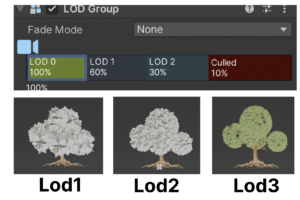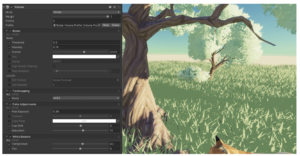Modular
I have utilized a modular approach to construct scenes, incorporating objects such as trees, rocks, and other elements. Initially, I created a series of one to three models, each possessing unique forms. These models were then transformed through the modification of their size, aspect ratios, rotations, and other similar variables, resulting in a diverse array of models. This methodology significantly increases the efficiency of scene creation and amplifies the complexity of details incorporated within the scene, rendering it more multifaceted and visually engaging. This modular approach further enables the prompt implementation of updates and modifications to the scene, thereby augmenting its versatility and maintainability.

Lod
I have used LOD to optimize rendering performance and improve the game performance by using simplified models or materials for objects that are far away from the camera. To achieve this, I first created three different detail levels of tree models in Blender. Then, in the Unity scene, I created a LOD Group component and attached the different detail levels of models to the component. Finally, I adjusted the distances between the different levels of detail according to the object’s distance from the camera. By doing so, Unity will automatically switch to an appropriate level of detail for each object, based on the distance between the object and the camera, which helps to optimize performance without sacrificing visual quality.

Lighting:Post-Process
I used post-processing effects, such as color correction, depth of field, motion blur, and ambient occlusion, to add various visual enhancements to the game scene. I also adjusted the color correction parameters, such as saturation, brightness, and contrast, to enhance the scene’s lighting and improve the game’s immersion and player experience. However, due to compatibility issues with VR, I ultimately decided to abandon the use of post-processing effects. Specifically, VR cameras cannot choose to render through post-processing effects, and rendering through post-processing effects may also affect the game’s performance and stability. Therefore, I decided not to use post-processing effects in VR mode to ensure the game’s smoothness and stability in VR.


